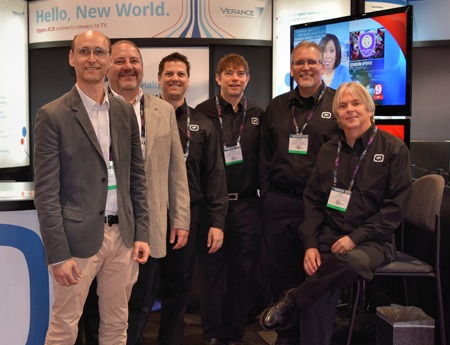Verance Wants to Smarten Up TVs

The next-generation broadcast standard ATSC 3.0 won’t be implemented until at least 2017, but one of its most important features, the open VP1 automatic content recognition technologies from Verance, is likely to start making its way into the market much earlier.
“We are in field trials with a number of different commercial entities,” said Joe Winograd, executive VP and CTO of Verance, which recently won a 2015 Emmy for Technology/Engineering Achievement for its long history of developing watermarking technologies and the VP1 system. Announcements about commercial deployments are expected in the coming months.
That’s important because automatic content recognition systems promise to dramatically change the delivery of video to TV, making it possible for broadcasters, networks and content creators to send more personalized content and create new revenue from their programming.
OPENING UP RECOGNITION
One major advantage is that VP1 is an open standard. CE manufacturers have been deploying automatic content recognition (ACR) technologies into TV sets since 2012, but have adopted a number of different proprietary standards.
“The multiplicity of solutions for content recognition has created a very fragmented marketplace, where every TV set maker has built their own or brought in an outside proprietary solution,” Winograd said. “There is no way that broadcasters can customize their programming for 20 different set manufacturers and that is why ATSC decided to adopt a single open standard for this problem.”
Another issue is privacy. A number of other ACR systems use third-party companies to detect what content is being watched, which means that data about viewing habits is being fed to outside firms that consumers don’t have a direct relationship with.
Broadcasting & Cable Newsletter
The smarter way to stay on top of broadcasting and cable industry. Sign up below
In contrast, the data in the VP1 system remains with the broadcaster because the data flows from the user’s device to a server under the control of the broadcaster, an architecture that is similar to the way data is collected by programmers from their websites.
“I don’t think that a lot of consumers understand their smart TVs are currently providing data to outside third-party companies,” Winograd said. “The fact that data is under the direct control of the broadcaster and the data is under the direct control of the broadcaster without being beholden to an ACR middleman or a third party is one of the reasons why broadcasters are enthusiastic about this technology.”
The biggest pluses, however, are the opportunities that ACR opens up for broadcasters to improve the consumer experience and to develop new services and business models.
“Originally there was a direct link from the broadcaster via a transmitter tower to the consumer and a TV set,” Winograd explained. “Today, programming much more commonly is going through a cable plant or increasingly the Internet and over-the-top with a broadband connection that they don’t control. That makes it more difficult for broadcasters to compete against other digital media platforms that are vertically integrated and can control the distribution of content to provide better functionality, measurement and interactivity.”
SPECIAL DELIVERY
The VP1 system allows HTML5 scripts to be delivered over cable, satellite, broadband and other distribution systems so that devices could recognize the content. As a result, viewers could then personalize programming with alternative languages and customized audio for a foreign language speaker in the house or a person with a hearing disability.
That would also bring interactivity to the TV set so that consumers could have a better back and forth with content, accessing real-time stats and other features, and enabling much improved measurement and dynamic ad insertion targeting to individual devices.
“There is a set of viewer benefits that we think will motivate viewers to purchase new TV sets in the transition to ATSC 3.0,” said Winograd. “And for broadcasters it will give them a two-way platform that will allow them to compete much more effectively with digital media platforms that can offer interactivity and targeted advertising.”
The VP1 technology builds on a long history of tech development in watermarking technologies for tracking content; that was one reason Verance won its Emmy, Winograd said.
Verance introduced watermarking to the TV industry in 1999 and that same year its VCMS/a audio watermarking technology was selected as a mandatory component of DVD-Audio, SD-Audio and SDMI Portable Device consumer product formats. Later, its ConfirMedia audio watermarks were used in over 10,000 broadcast works and over 100 million broadcast events; its Cinavia audio watermarking technology is a mandatory component of the Blu-ray disk format.
“VP1 is based on our 20-year history of delivering solutions to the TV industry,” Winograd said. “We think it is a breakthrough that will help the ACR market deliver on its promise.”










